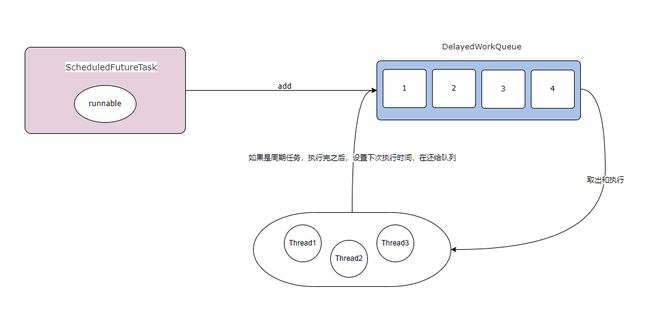ScheduledThreadPoolExecutor周期定时任务异常处理踩坑的问题!!
问题原因
在公司写项目的时候,有一个周期定时任务的需求,就想着阿里巴巴开发手册里不是说不能用Executors去创建线程池,因为存在如下问题:
- FixedThreadPool和SingleThreadPool:允许的请求队列长度为 Integer.MAX_VALUE,可能会堆积大量的请求,从而导致 OOM。
- CachedThreadPool:允许的创建线程数量为 Integer.MAX_VALUE,可能会创建大量的线程,从而导致 OOM。
然后就没用Executors.newScheduledThreadPool(),然后自己new一个ScheduledThreadPoolExecutor对象,并重写了afterExecute方法,和自定义拒绝策略。
结果运行起来只执行一次就不打印日志了,这个问题困扰了我半天,所以留个笔记记录下来。
代码如下:
@Slf4j
@Component
public class PlanStartAndEndTask implements ApplicationRunner {
/**
* 初始化定时任务线程池
*/
private final ScheduledThreadPoolExecutor executor = new ScheduledThreadPoolExecutor(1, new RecordExceptionExecutionHandler()) {
/**
* 自定义异常处理
* @param runnable 任务
* @param throwable 异常
* @date 2021/3/31
*/
@Override
protected void afterExecute(Runnable runnable, Throwable throwable) {
final Logger log = LoggerFactory.getLogger(this.getClass());
if (runnable instanceof Thread) {
if (throwable != null) {
log.error("自动开始/结束分享计划的定时任务出现异常,时间:{},异常信息:{}", LocalDateTime.now(), throwable.getMessage());
}
} else if (runnable instanceof FutureTask) {
FutureTask<?> futureTask = (FutureTask<?>) runnable;
try {
// 问题就出在这!!!
futureTask.get();
} catch (InterruptedException e) {
log.error("自动开始/结束分享计划的定时任务被打断,时间:{}", LocalDateTime.now());
Thread.currentThread().interrupt();
} catch (ExecutionException e) {
log.error("自动开始/结束分享计划的定时任务出现异常,时间:{},异常信息:{}", LocalDateTime.now(), e.getMessage());
}
}
}
};
@Override
public void run(ApplicationArguments args) throws Exception {
// 为了模拟,首次延时时间0,周期为5秒钟一次
executor.scheduleAtFixedRate(() -> {
long startTime = System.currentTimeMillis();
log.info("开始执行自动化任务");
/** 省略业务代码 **/
log.info("结束执行自动化任务,耗时:{}毫秒;", System.currentTimeMillis() - startTime);
}, 0, 5000, TimeUnit.MILLISECONDS);
}
/**
* 自定义实现拒绝策略,记录日志,队列满了之后,新任务被提交会直接被丢弃掉
*
* @author Zhu Lin
* @date 2021/3/30
*/
@Slf4j
static class RecordExceptionExecutionHandler implements RejectedExecutionHandler {
@Override
public void rejectedExecution(Runnable runnable, ThreadPoolExecutor threadPoolExecutor) {
log.error("任务:{}, 被{}拒绝 ", runnable.toString(), threadPoolExecutor.toString());
}
}
}
然后起初我以为是异常的问题导致只执行一次就不执行了,控制台也不打印异常信息,因为JavaDoc中也是这么说的
/**
* Creates and executes a periodic action that becomes enabled first
* after the given initial delay, and subsequently with the given
* period; that is executions will commence after
* {@code initialDelay} then {@code initialDelay+period}, then
* {@code initialDelay + 2 * period}, and so on.
* If any execution of the task
* encounters an exception, subsequent executions are suppressed.
* Otherwise, the task will only terminate via cancellation or
* termination of the executor. If any execution of this task
* takes longer than its period, then subsequent executions
* may start late, but will not concurrently execute.
*
* @param command the task to execute
* @param initialDelay the time to delay first execution
* @param period the period between successive executions
* @param unit the time unit of the initialDelay and period parameters
* @return a ScheduledFuture representing pending completion of
* the task, and whose {@code get()} method will throw an
* exception upon cancellation
* @throws RejectedExecutionException if the task cannot be
* scheduled for execution
* @throws NullPointerException if command is null
* @throws IllegalArgumentException if period less than or equal to zero
*/
public ScheduledFuture<?> scheduleAtFixedRate(Runnable command,
long initialDelay,
long period,
TimeUnit unit);
简单来说就是,任务只有遇到异常时才会停止,否贼只有取消和终止执行程序才能终止任务
所以我就改成这样
@Override
public void run(ApplicationArguments args) throws Exception {
// 首次延时时间0,周期为5秒钟一次
executor.scheduleAtFixedRate(() -> {
long startTime = System.currentTimeMillis();
try {
log.info("开始执行自动化任务");
} catch (Exception e) {
log.error("自动开始/结束分享计划的定时任务出现异常,时间:{},异常信息:{}", LocalDateTime.now(), e.getMessage());
} finally {
log.info("结束执行自动化任务,耗时:{}毫秒;", System.currentTimeMillis() - startTime);
}
}, 0, 5000, TimeUnit.MILLISECONDS);
}
事实证明压根不是这个问题,毕竟我里面啥都没干,就打印日志,抛啥子异常咯~,然后我试了好多遍,终于在我把afterExecutor给注释掉后,程序居然正常了!最后我把问题定位到 futureTask.get() 这行代码上,通过debug发现,线程执行到这行代码之后就不会往下走了,那么原因到底是什么?我们深入来看一下
问题解析
首先我们先看看为什么get()会被阻塞住
public V get() throws InterruptedException, ExecutionException {
int s = state;
// 如果任务已经在执行中了,那么就进入等待
if (s <= COMPLETING)
s = awaitDone(false, 0L);
return report(s);
}
// 等待任务执行完成
private int awaitDone(boolean timed, long nanos)
throws InterruptedException {
// 计算等待终止时间,如果一直等待的话,终止时间为 0
final long deadline = timed ? System.nanoTime() + nanos : 0L;
WaitNode q = null;
// 不排队
boolean queued = false;
// 无限循环
for (;;) {
// 如果线程已经被打断了,删除,抛异常
if (Thread.interrupted()) {
removeWaiter(q);
throw new InterruptedException();
}
// 当前任务状态
int s = state;
// 当前任务已经执行完了,返回
if (s > COMPLETING) {
// 当前任务的线程置空
if (q != null)
q.thread = null;
return s;
}
// 如果正在执行,当前线程让出 cpu,重新竞争,防止 cpu 飙高
else if (s == COMPLETING) // cannot time out yet
Thread.yield();
// 如果第一次运行,新建 waitNode,当前线程就是 waitNode 的属性
else if (q == null)
q = new WaitNode();
// 默认第一次都会执行这里,执行成功之后,queued 就为 true,就不会再执行了
// 把当前 waitNode 当做 waiters 链表的第一个
else if (!queued)
queued = UNSAFE.compareAndSwapObject(this, waitersOffset,
q.next = waiters, q);
// 如果设置了超时时间,并过了超时时间的话,从 waiters 链表中删除当前 wait
else if (timed) {
nanos = deadline - System.nanoTime();
if (nanos <= 0L) {
removeWaiter(q);
return state;
}
// 没有过超时时间,线程进入 TIMED_WAITING 状态
LockSupport.parkNanos(this, nanos);
}
// 没有设置超时时间,进入 WAITING 状态
else
LockSupport.park(this);
}
}
我们可以看到上面那行注释为“当前任务已经执行完了,返回”的代码,只要不满足这个条件,你就会被一直阻塞,那么问题肯定出在我提交的定时任务state从来就没有被改变,这又是为什么?我们继续深究
接下来我们看到ScheduledThreadPoolExecutor#scheduleAtFixedRate方法
public ScheduledFuture<?> scheduleAtFixedRate(Runnable command,
long initialDelay,
long period,
TimeUnit unit) {
if (command == null || unit == null)
throw new NullPointerException();
if (period <= 0)
throw new IllegalArgumentException();
ScheduledFutureTask<Void> sft =
new ScheduledFutureTask<Void>(command,
null,
triggerTime(initialDelay, unit),
unit.toNanos(period));
RunnableScheduledFuture<Void> t = decorateTask(command, sft);
sft.outerTask = t;
delayedExecute(t);
return t;
}
这里的核心逻辑就是将 Runnable 包装成了一个ScheduledFutureTask对象,这个包装是在FutureTask基础上增加了定时调度需要的一些数据。(FutureTask是线程池的核心类之一)decorateTask是一个钩子方法,用来给扩展用的,在这里的默认实现就是返回ScheduledFutureTask本身。
然后主逻辑就是通过delayedExecute放入队列中。

那么为什么我们的任务state状态没有改变,肯定就是ScheduledFutureTask的run方法啦。
/**
* Overrides FutureTask version so as to reset/requeue if periodic.
*/
public void run() {
// 是否是周期性任务
boolean periodic = isPeriodic();
// 如果不可以在当前状态下运行,就取消任务(将这个任务的状态设置为CANCELLED)。
if (!canRunInCurrentRunState(periodic))
cancel(false);
else if (!periodic)
// 如果不是周期性的任务,调用 FutureTask # run 方法
ScheduledFutureTask.super.run();
else if (ScheduledFutureTask.super.runAndReset()) {
// 如果是周期性的,设置下次执行时间
setNextRunTime();
// 再次将任务添加到队列中
reExecutePeriodic(outerTask);
}
}
我们重点看ScheduledFutureTask.super.runAndReset()方法,实际上调用的是其父类FutureTask的runAndReset()方法,这个方法会在执行成功之后重置线程状态,reset就是这个语义。同时我们可以看到,当方法执行返回false的时候,就不会再次将任务添加的队列中,这和我们最开始假设的异常情况是一致的
最后答案就在这个runAndReset和run方法的区别里:
public void run() {
/** 省略其他代码 **/
try {
// 执行任务
result = c.call();
ran = true;
} catch (Throwable ex) {
result = null;
ran = false;
setException(ex);
}
if (ran)
set(result);
/** 省略其他代码 **/
}
protected boolean runAndReset() {
/** 省略其他代码 **/
try {
// 执行任务
c.call(); // don't set result
ran = true;
} catch (Throwable ex) {
setException(ex);
}
/** 省略其他代码 **/
}
上面的代码我省略掉了大部分,只留出了这次问题所在的地方,感兴趣的小伙伴可以自己去ide里看看,c.call()是执行任务的地方,这里有一个默认为false的ran变量,当任务执行成功时,ran会被设成 true,即任务已执行。但这不是关键,关键是我们发现run方法里在成功后回去调一个set方法
protected void set(V v) {
if (UNSAFE.compareAndSwapInt(this, stateOffset, NEW, COMPLETING)) {
outcome = v;
UNSAFE.putOrderedInt(this, stateOffset, NORMAL); // final state
finishCompletion();
}
}
在set方法中修改了state的状态,这也证明了我们之前的逻辑,周期任务调runAndReset压根不去修改state,所以get方法只能阻塞,没有其他选择。
小疑惑
其实如果按阿里巴巴开发手册的规范来说的话,ScheduledThreadPoolExecutor也存在允许创建的线程数据为Integer.MAX_VALUE的问题,那么该怎么解决呢,这点我有点疑惑。
public ScheduledThreadPoolExecutor(int corePoolSize) {
super(corePoolSize, Integer.MAX_VALUE, 0, NANOSECONDS,
new DelayedWorkQueue());
}